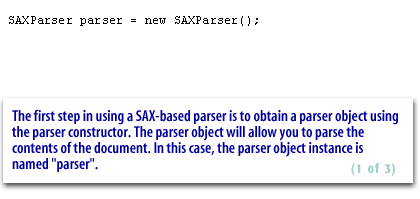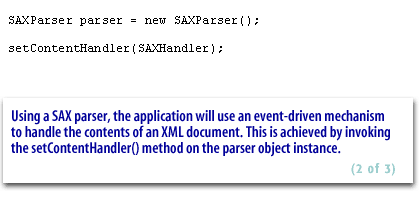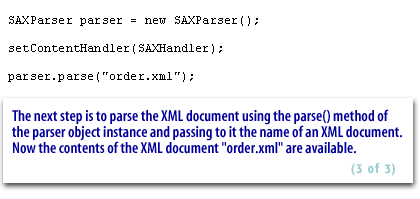| Lesson 4 | Using an XML parser |
| Objective | Outline the steps for using an XML parser. |
Using XML parser
Using an XML parser in an application to process an XML document involves the following steps:
- Create a parser object instance using either the DOM API or the SAX API.
- Pass your XML document to the parser object.
- Parse the XML document using the methods of the parser object.
- Process the result.

1) The first step in using a SAX based parser is to obtain a parser
object using the parser constructor .

2) Using a SAX parser, the application will use an event-driven mechanism to handle the contents of an XML document.

3) The next step is to parse the XML document using the parse() , method of the parser object instance and passing to the name of an XML document
What are the Steps for using an XML Parser?
The steps for using an XML parser typically include:
The exact steps involved in using an XML parser can vary depending on the specific parser being used and the programming language or platform in which it is being used. However, these steps provide a general overview of the typical process involved in using an XML parser.
- Loading the XML document: This involves reading the XML document from a file or another source into memory, so that it can be processed by the parser.
- Initializing the parser: The parser must be initialized before it can be used. This typically involves creating an instance of the parser and setting any configuration options that are necessary.
- Parsing the XML document: This is the core step in which the parser processes the XML document and converts it into a hierarchical structure, such as a Document Object Model (DOM) or a Simple API for XML (SAX) event stream.
- Traversing the resulting structure: After the parser has processed the XML document, applications can traverse the resulting structure to access the data contained within the document. This typically involves navigating the tree-like structure of the DOM or processing the events in the SAX event stream.
- Modifying the XML document: If necessary, applications can also modify the data in the XML document by updating the nodes in the DOM or generating new events in the SAX event stream.
- Serializing the modified document: After the necessary modifications have been made, the resulting structure can be converted back into an XML document, typically by serializing the DOM or generating an XML document from the SAX events.
The exact steps involved in using an XML parser can vary depending on the specific parser being used and the programming language or platform in which it is being used. However, these steps provide a general overview of the typical process involved in using an XML parser.
The next lesson explains the Document Object Model (DOM) for parsing XML documents.
Choosing Correct Parser - Exercise
Click the Exercise link below to match the type of parser to the correct scenario.
Choosing Correct Parser - Exercise
Choosing Correct Parser - Exercise